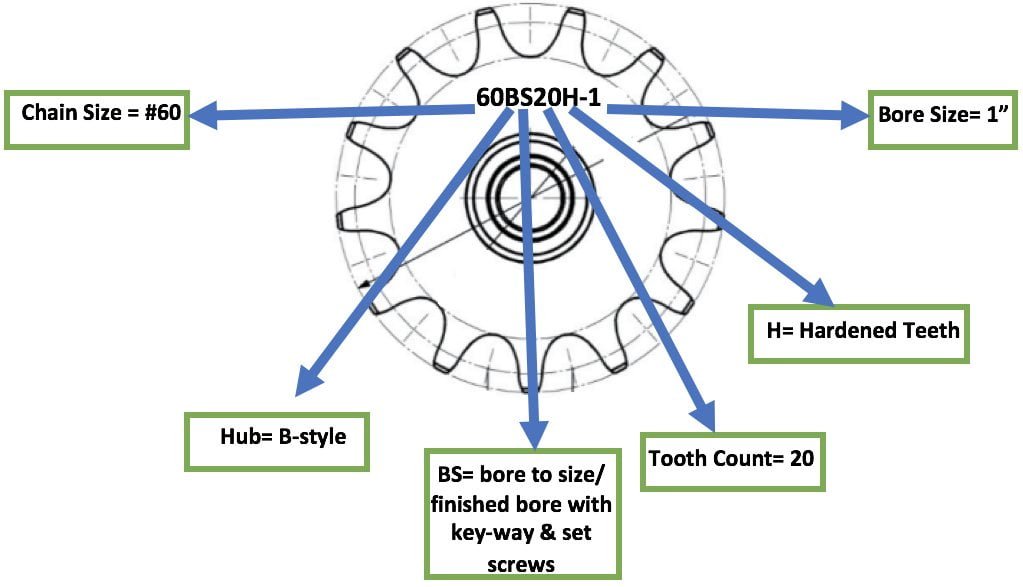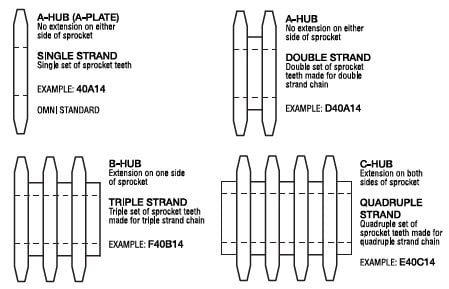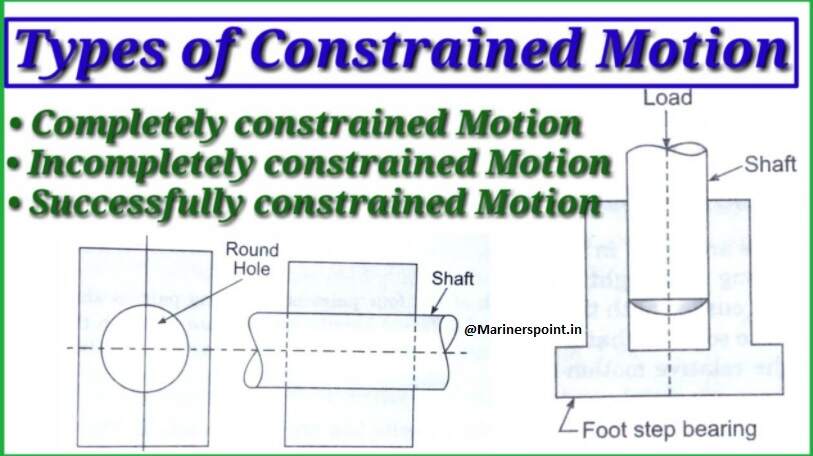In this article we are going to discuss about sprockets, Types of sprockets and what are their uses and specifications in details.
What is sprocket ?
A sprocket, or a sprocket-wheel or a chainwheel, also known as a profiled wheel, is a wheel with teeth that mesh with a chain, track, or other perforated or indented material. The term ‘sprocket‘ refers to any wheel with radial projections that engage a chain passing over it.
It differs from a gear in that sprockets are never directly meshed together, and it differs from a pulley in that sprockets have teeth and pulleys are smooth, with the exception of timing pulleys used with toothed belts.
A sprocket is a wheel with teeth that connect to a chain. When it rotates, the teeth hold the chain in place and move the chain’s other components.
What Sprocket Means ?
It is a toothed wheel whose teeth engage the links of a chain.
or, we can say ,it is a cylinder with teeth around the circumference at either end which projects through perforations in something (such as motion-picture film) to move it through a mechanism (such as a projector).
What is an example of sprockets
These are rotating toothed wheels that engage with roller or conveyor chains to transmit power or convey materials.
A bicycle sprocket, for example, transmits rotation from the pedals to the wheel.
What is another word for sprocket?
A toothed wheel that enmeshes with a chain or other perforated band
A grooved wheel that can interlock and convey motion from one to the other.
Classification
Sprockets are classified into four types: type A, type B, type C, and type D, which are discussed below:
Type A
Type A : – These types of sprockets are flat and do not have a hub. They are typically mounted on the flanges or hubs of the device they are driving through a series of plain or tapered holes.
Type B :- These Sprockets have a hub on one side, which allows the sprocket to be tightly fitted to the machinery to which it is attached. This eliminates a significant overhung load on the equipment’s bearings.
Type C :- These types of sprockets are extended on both sides of the plate and are typically used on the driven sprocket where the pitch diameter is greater and there is more weight to support on the shaft. Larger loads require larger hubs.
Type D : – These sprockets make use of a type A sprocket mounted on a solid or split hub. The sprocket is split and bolted to the hub for easy removal. It is possible to change the speed ratio without having to remove bearings and other equipment.

Types of sprockets
- Chain sprockets
- Duplex sprockets
- Industrial sprockets
- Drive sprockets
- Triplex Sprocket
- Shaft Sprocket
- Simplex sprocket
- Single pitch and double pitch sprocket
- Drum Sprocket
- Steel split Sprocket
- Idler sprocket
- Bushed Sprocket
- Multi-sprand sprocket
- Quick disconnect Sprocket
- Taper lock sprocket
- Double plus sprocket
1. Chain Sprockets

These are the most commonly used sprockets. They only work with chains made of rollers connected by pins.
Roller chains transfer rotary motion by creating a gap that fits the teeth of the sprocket. These are commonly found in transmission equipment.
2. Simplex Sprockets
It is separated by a pulley and is divided by a gear in which the sprocket is not directly joined together. They are typically constructed of teeth and smooth pulleys. These are typically devoid of a flange.
3. Duplex Sprockets
Duplex are typically made of mild steel and, in some cases, stainless steel, and come in a variety of sizes. It is mostly made up of double-strand sprockets with outer diameters ranging from 2′′ to 120′′ in the plate.
It could be a single hub or a double hub, depending on the specifications. Duplex Sprockets with Induction/Flame hardened teeth are also available.
4. Triplex Sprocket
It is a triple 18 tooth taper bushed sprocket with bushing. It is made of high-quality mild steel and is fabricated with tight tolerances for long-term performance. These have heat-treated hardened teeth, which improves their working and durability even more.
5. Industrial Sprocket
Because of their high tensile strength and efficiency, these are typically made of graded stainless steel, mild steel, and cast iron.
To improve efficiency, their originator can manufacture various types of sprockets. They are typically used with timing belts and have flanges to keep the belt centered.
6. Drive sprocket
These types of sprockets are usually provided with the shaft import power (usually the smaller diameter sprocket).
Drive sprockets are a common type of sprocket. These are usually equipped with shaft import power. They are also available in a smaller diameter.
7. Shaft Sprocket
It is a type of sprocket that is typically made of welded steel and is either one piece or has replaceable tooth segments for the drive and tail sections. They’re frequently used in ash-handling applications. These are available with a variety of tooth counts and hub designs.
8. Single and Double Pitch Sprockets
Single pitch and double pitch sprockets are available for pitch sprocket. The teeth on the single-pitch allows the chain’s roller pin to fall into each tooth. The double pitch sprocket, on the other hand, has teeth that allow the pin to fall into each gap. Because conveyor systems require precise product placement, this type of sprocket is used.
What does pitch mean on a sprocket?
Pitch represents the amount of pitch diameter in inches per tooth. Sprocket with a larger pitch will have bigger teeth.
9. Drum Sprocket
These types of sprockets are thicker and stronger, with an emphasis on reducing contact pressure through increased surface area. Teeth, plates, and hubs are used in a wide range of applications to reduce wear. Heavy-duty and industrial applications call for drum sprockets.
10. Steel Split Sprocket
Split sprocket is an ideal sprocket, especially in areas where working space is limited. They are simple and easy to assemble in difficult-to-reach areas. Split sprocket for conveyor and wood processing chains enable the sprocket to be assembled without dismounting the shaft assembly.
Several sprockets are required by loosening the chain, inserting the sprocket, and tightening the chain again. Because a steel-split sprocket is made up of two parts that are split through the center and bolted back together, it is easy to fit into a system.
Steel split sprockets are split through the entire radius for easy installation and removal. The halves are held together by bolts. This style is available in pitch sizes 40 through 240, and bore diameters of 3/4 through 6 in.
11. Idler sprocket
These are a flat hub less sprocket with a sealed bearing that allows it to rotate freely. Idlers are typically fixedly mounted on a fixed shaft or attached to a tensioner arm.
It is used in situations where long lengths of chain may cause slack, there is a non-adjustable drive shaft, or the chain is guided around an obstacle. Idle sprockets prevent chain whipping and uneven load distribution.
12. Bushed Sprockets
These types of sprockets provide support, such as anchor bolts, to ensure that the flange is securely attached to the sprocket. Bushing sprockets are often used in heavy lifting systems.
13. Multi Strand Sprocket
Multi-strand sprockets are used when higher torque and power are required, or when two or more items are powered by the same drive shaft. Available in chain pitches ranging from 40 to 160, with plain, finished, taper-lock, or QD hubs.
14. Quick Disconnect Sprocket
These sprocket are used in applications with a high working load and a high clamp loading on the shaft. Anchor bolts surround the perimeter of QD sprockets.
15. Taper Lock Sprockets
Taper lock sprockets have teeth around the outside diameter of the sprocket body consisting of a centre machined to suit a Taper lock bush with a boss on one side.
To provide a clamp on the shaft, this sprocket has a split through the taper and flange. The set screw on the sprocket holds the taper-lock bushing in place.
16. Double Plus Sprocket
Double Plus sprockets are specifically designed for use with Double Plus chain and are used in conveyor applications where a product is moving at twice the speed of the drive system powering the conveyor. The advantages include less noise and a longer chain life.
The Double Plus sprocket was designed specifically for use with the Double Plus chain. They are used in conveyor applications to power the conveyor when the product is moving at a high speed.
Sprocket Part Number Explanation
When identifying a sprocket with a part number, the chain pitch is typically written first, followed by the hub style or code, and finally the number of teeth. If the sprocket is multi-stranded, the part number will usually begin with a letter prefix.
If the teeth have been heat-treated, a suffix of “H” is added behind the part number. If the sprocket is QD or taper bushed, the center letter for the hub designation is changed to reflect this.

Some manufactures will also designate in the part number if the sprocket is manufactured from a special material. This designation can be placed in the front of the part number or behind, if it is noted.
Sprockets Selection Terminology
1. Sprocket Hub Style :- Many US manufacturers offer A, B, and C style hub configurations.
2. Sprocket caliper diameter :- The distance between sprocket tooth valleys on the opposite side. It measures the diameter of the sprocket plate without the teeth.
3. Sprocket outside diameter :- The distance measured from one side’s sprocket tooth peak to the opposite side’s sprocket tooth peak.
4. Maximum bore diameters :- Maximum bore size a sprocket can be machined without compromising structural integrity (B, C Styles).
5. Length through bore diameter :- The inside diameter of the hub and the length to which it was machined. To withstand shear and torque stress, the length must be able to accommodate the appropriate size keyway.
6. Plain bore :- (B and C Styles), the inside diameter of the hub is machined with a standard keyway and two set screws.
What is Sprocket used for ?
Sprockets are used in bicycles, motorcycles, tracked vehicles, and other machinery either to transmit rotary motion between two shafts where gears are unsuitable or to impart linear motion to a track, tape etc.
How do I measure Sprocket chain Designation
The sprocket size represents the first two digits in the chain designation.
Example: 40A14 is size 40.
The number of teeth represents the last two digits in the chain designation.
Count the number of teeth.
Example: 40A14-14 teeth
Determine the sprocket type:
A-Hub-No extension on either side of sprocket (A)
B-Hub-Extension on one side of sprocket (B)
C-Hub-Extensions on both sides of sprocket (C)
The sprocket can be single,double(D),triple(F),and quadruple(E)strand sprockets,each respectively having single,double,triple,and quadruple sets of teeth.

The sprocket can be double single(DS),which has a double set of teeth made for two single strands of chain.

Determine the sprocket type for the chain designation by assigning the respective letter or number.
The hub style represents the middle letter.
Example: 40A14-A-Hub.
The strand style represents the first letters.
Example: DS40A14-doulbe strand.
Applications of Sprockets
There are various types of sprockets available, each of which is used on various types of machinery to run on movement in various applications. The following are some of the most common uses for sprockets:
These are commonly found in agricultural and farming equipment. These are used in automotive equipment as well. It’s found in chain-driven machinery like conveyor belts and other factory systems.
Sprockets are extremely useful in pulleys, shafts, and other types of power transmission equipment. In-vehicle systems, such as bicycles and motorcycles, are also used.
Hope you have learned about different types of sprockets. Please let us know about the feedback of the article in the comments below.
FAQ
What type of gear is a sprocket?
Sprocket – Sprockets, also known as sprocket wheels, have teeth that mesh with the links of chains or belts. Sprockets differ from gears in that they are never directly mesh together. Sprockets come in a variety of designs, including quiet chain, roller, and ladder sprockets.
Check Out Other Important Topics
Plant Layout – Types, Objectives, Principles, Advantages
Types of Punches – Uses, Working, Applications, Pictures
Types of Dies – Classification, Uses, Pictures
Types of Rivets – Working & Their Uses [with Images]
Types of Fasteners – Uses & Examples [with Pictures]
| IC Engine | Important PDFs | Boilers | Synergy Maritime Exam | Naval Arch | MEO Class 4 |
| Interview Questions | Difference Between | Types of Pumps | Auxiliary Machines | Types of Valves | Home |




